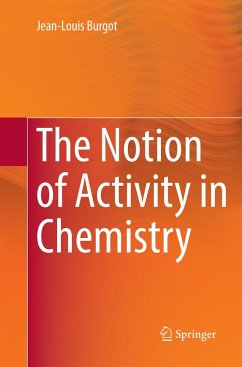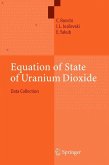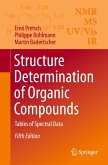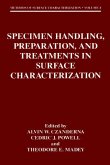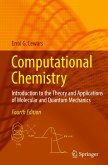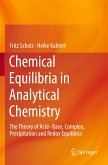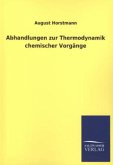Jean-Louis Burgot
The Notion of Activity in Chemistry
Jean-Louis Burgot
The Notion of Activity in Chemistry
- Broschiertes Buch
- Merkliste
- Auf die Merkliste
- Bewerten Bewerten
- Teilen
- Produkt teilen
- Produkterinnerung
- Produkterinnerung
This book provides deep insight into the physical quantity known as chemical activity. The author probes deep into classical thermodynamics in Part I, and then into statistical thermodynamics in Part II, to provide the necessary background. The treatment has been streamlined by placing some background material in appendices. Chemical Activity is of interest not only to those in chemical thermodynamics, but also to chemical engineers working with mass transfer and its applications - for example, separation methods.
Andere Kunden interessierten sich auch für
![Equation of State of Uranium Dioxide Equation of State of Uranium Dioxide]() C. RonchiEquation of State of Uranium Dioxide118,99 €
C. RonchiEquation of State of Uranium Dioxide118,99 €![Structure Determination of Organic Compounds Structure Determination of Organic Compounds]() Ernö PretschStructure Determination of Organic Compounds52,99 €
Ernö PretschStructure Determination of Organic Compounds52,99 €![Specimen Handling, Preparation, and Treatments in Surface Characterization Specimen Handling, Preparation, and Treatments in Surface Characterization]() Alvin W. Czanderna / Cedric J. Powell / Theodore E. Madey (eds.)Specimen Handling, Preparation, and Treatments in Surface Characterization112,99 €
Alvin W. Czanderna / Cedric J. Powell / Theodore E. Madey (eds.)Specimen Handling, Preparation, and Treatments in Surface Characterization112,99 €![Computational Chemistry Computational Chemistry]() Errol G. LewarsComputational Chemistry76,99 €
Errol G. LewarsComputational Chemistry76,99 €![Computational Chemistry Computational Chemistry]() Errol G. LewarsComputational Chemistry98,99 €
Errol G. LewarsComputational Chemistry98,99 €![Chemical Equilibria in Analytical Chemistry Chemical Equilibria in Analytical Chemistry]() Fritz ScholzChemical Equilibria in Analytical Chemistry45,99 €
Fritz ScholzChemical Equilibria in Analytical Chemistry45,99 €![Abhandlungen zur Thermodynamik chemischer Vorgänge Abhandlungen zur Thermodynamik chemischer Vorgänge]() August HorstmannAbhandlungen zur Thermodynamik chemischer Vorgänge16,90 €
August HorstmannAbhandlungen zur Thermodynamik chemischer Vorgänge16,90 €-
-
-
This book provides deep insight into the physical quantity known as chemical activity. The author probes deep into classical thermodynamics in Part I, and then into statistical thermodynamics in Part II, to provide the necessary background. The treatment has been streamlined by placing some background material in appendices. Chemical Activity is of interest not only to those in chemical thermodynamics, but also to chemical engineers working with mass transfer and its applications - for example, separation methods.
Produktdetails
- Produktdetails
- Verlag: Springer / Springer International Publishing / Springer, Berlin
- Artikelnr. des Verlages: 978-3-319-83511-2
- Softcover reprint of the original 1st ed. 2017
- Seitenzahl: 652
- Erscheinungstermin: 29. April 2018
- Englisch
- Abmessung: 235mm x 155mm x 35mm
- Gewicht: 985g
- ISBN-13: 9783319835112
- ISBN-10: 3319835114
- Artikelnr.: 53571218
- Herstellerkennzeichnung Die Herstellerinformationen sind derzeit nicht verfügbar.
- Verlag: Springer / Springer International Publishing / Springer, Berlin
- Artikelnr. des Verlages: 978-3-319-83511-2
- Softcover reprint of the original 1st ed. 2017
- Seitenzahl: 652
- Erscheinungstermin: 29. April 2018
- Englisch
- Abmessung: 235mm x 155mm x 35mm
- Gewicht: 985g
- ISBN-13: 9783319835112
- ISBN-10: 3319835114
- Artikelnr.: 53571218
- Herstellerkennzeichnung Die Herstellerinformationen sind derzeit nicht verfügbar.
Jean-Louis Burgot is a retired Professor of analytical chemistry in Rennes, France.
1st part: The Activity in Classical Thermodynamics.- Thermodynamic systems.- Gibbs and Helmhotz energies.- Escaping tendency and molar Gibbs energy.- Partial molar properties.- Chemical potential or partial molar Gibbs energy.- An overview of the notion of activity.- The concept of fugacity.- Ideal solutions.- Definitions of the activity.- Activity of a gaz.- Activities of non- electrolytes in solutions.- Activities of electrolytes: definitions.- Determination of the activity of non-electrolytes.- Determination of the activity of electrolytes.- Debye and Hückel 's relations.- Excess Gibbs energies and activities.- Chemical equilibrium constants : activities and Gibbs energies of reactions.- Derivation of thermodynamic equilibrium constants- pH and its measure.- General principles of calculations of ionic species concentrations in solutions involving activities .- 2nd part: The Activity in Statistical Thermodynamics.- Statistical thermodynamics in brief.- Concept of ensembles and postulates.- The canonical ensemble: notion of distribution.- Thermodynamic quantities in the framework of the canonical ensemble.- Other ensembles .- Systems of molecules and subsystems independent distinguishable and "indistinguishable".- Perfect gases.- Classical statistical mechanics- Notion of configuration - Classical canonical partition function.- The configurational partition function - Molecular distribution functions.- The radial distribution function.- Radial distribution function and thermodynamic quantities- calculations of the internal energy and of the pressure of a system.- Radial distribution function and calculation of the isothermal compressibility coefficient of a system.- The chemical potential and the radial distribution function: General formal introduction of the activity and of the activity coefficient.- Imperfect gases - The virial coefficients in terms of interaction potential energies.- A statistical expression of the activity: A relation between it and the concentration in the case of an imperfect gaz.- Activities of gases in a mixture of imperfect gases.- Chemical equilibria between gases and statistical thermodynamics.- Activity coefficients of gases.- Activities and concentrations of non-electrolytes in dilute liquid solutions - McMillan- Mayer's theory of their osmotic pressure.- A study of dilute solutions of non-electrolytes at constant pressure and temperature.- The activity coefficients of solutes in binary non-electrolyte solutions.- Molecular distribution functions in binary mixtures.- The Kirkwood-Buff's theory- Changes of chemical potentials of solutes with their concentrations at constant pressure and temperature.- Expressions of the chemical potentials of the components of ideal solutions of non-electrolytes.
1st part: The Activity in Classical Thermodynamics.- Thermodynamic systems.- Gibbs and Helmhotz energies.- Escaping tendency and molar Gibbs energy.- Partial molar properties.- Chemical potential or partial molar Gibbs energy.- An overview of the notion of activity.- The concept of fugacity.- Ideal solutions.- Definitions of the activity.- Activity of a gaz.- Activities of non- electrolytes in solutions.- Activities of electrolytes: definitions.- Determination of the activity of non-electrolytes.- Determination of the activity of electrolytes.- Debye and Hückel 's relations.- Excess Gibbs energies and activities.- Chemical equilibrium constants : activities and Gibbs energies of reactions.- Derivation of thermodynamic equilibrium constants- pH and its measure.- General principles of calculations of ionic species concentrations in solutions involving activities .- 2nd part: The Activity in Statistical Thermodynamics.- Statistical thermodynamics in brief.- Concept of ensembles and postulates.- The canonical ensemble: notion of distribution.- Thermodynamic quantities in the framework of the canonical ensemble.- Other ensembles .- Systems of molecules and subsystems independent distinguishable and "indistinguishable".- Perfect gases.- Classical statistical mechanics- Notion of configuration - Classical canonical partition function.- The configurational partition function - Molecular distribution functions.- The radial distribution function.- Radial distribution function and thermodynamic quantities- calculations of the internal energy and of the pressure of a system.- Radial distribution function and calculation of the isothermal compressibility coefficient of a system.- The chemical potential and the radial distribution function: General formal introduction of the activity and of the activity coefficient.- Imperfect gases - The virial coefficients in terms of interaction potential energies.- A statistical expression of the activity: A relation between it and the concentration in the case of an imperfect gaz.- Activities of gases in a mixture of imperfect gases.- Chemical equilibria between gases and statistical thermodynamics.- Activity coefficients of gases.- Activities and concentrations of non-electrolytes in dilute liquid solutions - McMillan- Mayer's theory of their osmotic pressure.- A study of dilute solutions of non-electrolytes at constant pressure and temperature.- The activity coefficients of solutes in binary non-electrolyte solutions.- Molecular distribution functions in binary mixtures.- The Kirkwood-Buff's theory- Changes of chemical potentials of solutes with their concentrations at constant pressure and temperature.- Expressions of the chemical potentials of the components of ideal solutions of non-electrolytes.

